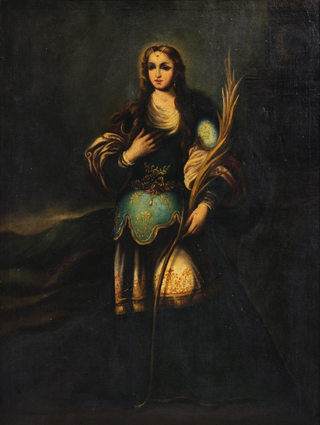Related Research Articles

Agnes of Rome is a virgin martyr, venerated as a saint in the Catholic Church, Oriental Orthodox Church and the Eastern Orthodox Church, as well as the Anglican Communion and Lutheran Churches. She is one of several virgin martyrs commemorated by name in the Canon of the Mass.

Philomena, also known as Saint Philomena or Philomena of Rome was a virgin martyr whose remains were discovered on May 24–25, 1802, in the Catacomb of Priscilla. Three tiles enclosing the tomb bore an inscription, Pax Tecum Filumena, that was taken to indicate that her name was Filumena, the English form of which is Philomena. Philomena is the patron saint of infants, babies, and youth, and is known as "The Wonderworker".

Saint Valentine was a 3rd-century Roman saint, commemorated in Western Christianity on February 14 and in Eastern Orthodoxy on July 6. From the High Middle Ages, his Saints' Day has been associated with a tradition of courtly love. He is also a patron saint of Terni, epilepsy and beekeepers. Saint Valentine was a clergyman – either a priest or a bishop – in the Roman Empire who ministered to persecuted Christians. He was martyred and his body buried on the Via Flaminia on February 14, which has been observed as the Feast of Saint Valentine since at least the eighth century.

Saint Apollonia was one of a group of virgin martyrs who suffered in Alexandria during a local uprising against the Christians prior to the persecution of Decius. According to church tradition, her torture included having all of her teeth violently pulled out or shattered. For this reason, she is popularly regarded as the patroness of dentistry and those suffering from toothache or other dental problems. French court painter Jehan Fouquet painted the scene of St. Apollonia's torture in The Martyrdom of St. Apollonia.

Agathaof Sicily is a Christian saint. Her feast is on 5 February. Agatha was born in Catania, part of the Roman Province of Sicily, and was martyred c. 251. She is one of several virgin martyrs who are commemorated by name in the Canon of the Mass.

Ursula was a Romano-British Christian martyr and possible royal figure.

Saint Cecilia, also spelled Cecelia, was a Roman virgin martyr and is venerated in Catholic, Orthodox, Anglican, and some Lutheran churches, such as the Church of Sweden. She became the patroness of music and musicians, it being written that, as the musicians played at her wedding, Cecilia "sang in her heart to the Lord". Musical compositions are dedicated to her, and her feast, on 22 November, is the occasion of concerts and musical festivals. She is also known as Cecilia of Rome.

Saints Faith, Hope and Charity, are a group of Christian martyred saints, venerated together with their mother, Sofiia ("Wisdom").
Saint Nino was a woman who preached Christianity in the territory of Caucasian Iberia, of what is now part of Georgia. It resulted in the Christianization of the royal house of Iberia, with the consequent Christianization of Iberia.

Sep. 15 - Eastern Orthodox liturgical calendar - Sep. 17

Sant'Ambrogio e Carlo al Corso is a basilica church in Rome, Italy, facing onto the central part of the Via del Corso. The apse of the church faces across the street, the Mausoleum of Augustus on Via di Ripetta.

July 23 - Eastern Orthodox liturgical calendar - July 25

Saint Anastasia is a Christian saint and martyr who died at Sirmium in the Roman province of Pannonia Secunda. In the Eastern Orthodox Church, she is venerated as St. Anastasia the Pharmakolytria, i.e. "Deliverer from Potions". This epithet is also translated as "One who Cures (Wounds)" in Lampe's A Patristic Greek Lexicon.

Saints Chrysanthus and Daria are saints of the Early Christian period. Their names appear in the Martyrologium Hieronymianum, an early martyrs list, and a church in their honour was built over their reputed grave in Rome.

Emerentiana was a Roman virgin and martyr, who lived around the start of the 4th century. Her feast day is 23 January.

February 9 - Eastern Orthodox liturgical calendar - February 11

Saint Sophia of Rome is venerated as a Christian martyr. She is identified in hagiographical tradition with the figure of Sophia of Milan, the mother of Saints Faith, Hope and Charity, whose veneration is attested for the sixth century.

The title Virgin is an honorific bestowed on female saints and blesseds, primarily used in the Eastern Orthodox Church and the Catholic Church.

Christina of Bolsena, also known as Christine of Bolsena, or in the Eastern Orthodox Church as Christina the Great martyr, is venerated as a virgin martyr of the third century. Archaeological excavations of an underground cemetery constructed over her tomb have shown that she was venerated at Bolsena by the fourth century.

December 9 - Eastern Orthodox liturgical calendar - December 11
References
- 1 2 Butler, Alban (1866). The Lives of the Fathers, Martyrs, and Other Principal Saints. J. Duffy. pp. 103–104.
- 1 2 St. Soteris retrieved August 19th 2018
- ↑ St. Soteris, virgin and martyrR retrieved August 19th 2018
- ↑ Saint Soteris retrieved August 19th 2018
- ↑ Andrew Ekonomou. Byzantine Rome and the Greek Popes. Lexington books, 2007
- ↑ Tuker, Mildred Anna Rosalie; Malleson, Hope (1900). The Christian monuments of Rome. A. and C. Black. p. 345.